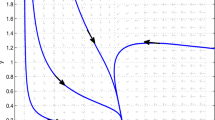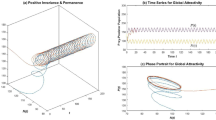Abstract
Lotka–Volterra differential equations deal with modeling of predator and prey populations and interrelation of population sizes in a continuous domain. Since all populations, be they predators or prays, are only the estimates in consequence of sampling process, this paper initially concerns with discretization schemes of one predator–prey Lotka–Volterra systems. Second-order Runge–Kutta approximation is used to discretize the original differential equations for flexibility to manipulate the system parameters. Subsequent to discretization, a novel predation scheme is introduced to enhance the rationalization of original model with age cluster-based and detailed rules which are based on reproductivity, predation ability, predation essentiality, food provision and consumption. Aging is also simulated with transitive structure of the algorithms that the alive individuals are getting older and changing clusters after the predation scheme is operated. Experiments revealed that our model exhibits not only fluctuations like the original model but also stable trajectories and fractal structure depending on the model parameters. Therefore, the main novelty of this paper briefly is the discovery of chaotic one predator–one prey system exhibiting chaotic behavior for a narrow interval and revealing a strange attractor which is very unique.







Similar content being viewed by others
References
Lotka, A.J.: Analytical note on certain rhythmic relations in organic systems. Proc. Natl. Acad. Sci. U. S. A. 6(7), 410–415 (1920)
Volterra, V.: Fluctuations in the abundance of a species considered mathematically. Nature 118, 558–560 (1926)
Goh, B.S.: Global stability in two species interactions. J. Math. Biol. 3(3–4), 313–318 (1976)
Kar, T.K., Ghorai, A.: Dynamic behaviour of a delayed predator–prey model with harvesting. Appl. Math. Comput. 217(22), 9085–9104 (2011)
Jana, S., Kar, T.K.: Modeling and analysis of a prey–predator system with disease in the prey. Chaos Solitons Fractals 47, 42–53 (2013)
Zhang, S., Dong, L., Chen, L.: The study of predator–prey system with defensive ability of prey and impulsive perturbations on the predator. Chaos Solitons Fractals 23(2), 631–643 (2005)
Jana, S., Ghorai, A., Guria, S., Kar, T.K.: Global dynamics of a predator, weaker prey and stronger prey system. Appl. Math. Comput. 250, 235–248 (2015)
Kar, T., Batabyal, A.: Persistence and stability of a two prey one predator system. Int. J. Eng. Sci. Technol. 2(2), 174–190 (2010)
Hutson, V., Vickers, G.: A criterion for permanent coexistence of species with an application to two prey, one predator system. Math. Biosci. 63, 253–269 (1983)
Kar, T., Chaudhury, K.: Harvesting in a two-prey one-predator fishery. ANZIAM J. 45, 443–456 (2004)
Elettreby, M.: Two-prey one-predator model. Chaos Solitons Fractals 39, 2018–2027 (2009)
Zhang, Y., Xiu, Z., Chen, L.: Dynamic complexity of a two-prey one-predator system with impulsive effect. Chaos Solitons Fractals 26, 131–139 (2005)
Butler, G., Waltman, P.: Bifurcation from a limit cycle in a two predator–one prey ecosystem modeled on a chemostat. J. Math. Biol. 12, 295–310 (1981)
Cushing, J.: Periodic two-predator, one-prey interactions and the time sharing of a resource niche. SIAM J. Appl. Math. 44, 392–410 (1984)
Farkas, M.: Zip bifurcation in a competition model. Nonlinear Anal. 8, 1295–1309 (1984)
Muratori, S., Rinaldi, S.: Remarks on competition coexistence, (1989). SIAM J. Appl. Math. 49, 1462–1472 (1989)
Smith, H.: The interaction of steady state and Hopf bifurcations in a two-predator one-prey competition model. SIAM J. Appl. Math. 42, 27–43 (1982)
May, R.M., Leonard, W.J.: Nonlinear aspects of competition between three species. SIAM J. Appl. Math. 29(2), 243–253 (1975)
Wang, R., Xiao, D.: Bifurcations and chaotic dynamics in a 4-dimensional competitive Lotka–Volterra system. Nonlinear Dyn. 59(3), 411–422 (2010)
Smale, S.: On the differential equations of species in compepetition. J. Math. Biol. 3, 5–7 (1976)
Vano, J.A., Wildenberg, J.C., Anderson, M.B., Noel, J.K., Sprott, J.C.: Chaos in low-dimensional Lotka–Volterra models of competition. Nonlinearity 19(10), 2391–2404 (2006)
Sprott, J.C., Wildenberg, J.C., Azizi, Y.: A simple spatiotemporal chaotic Lotka–Volterra model. Chaos Solitons Fractals 26(4), 1035–1043 (2005)
Geijzendorffer, I.R., Van der Werf, W., Bianchi, F.J.J.A., Schulte, R.P.O.: Sustained dynamic transience in a Lotka–Volterra competition model system for grassland species. Ecol. Model. 222(15), 2817–2824 (2011)
Thierry, H., Sheeren, D., Marilleau, N., Corson, N., Amalric, M., Monteil, C.: From the Lotka–Volterra model to a spatialised population-driven individual-based model. Ecol. Model. (2014). https://doi.org/10.1016/j.ecolmodel.2014.09.022
Llibre, J., Xiao, D.: Global dynamics of a Lotka–Volterra model with two predators competing for one prey. SIAM J. Appl. Math. 74(2), 434–453 (2014)
Jiang, D., Ji, C., Li, X., O’Regan, D.: Analysis of autonomous Lotka–Volterra competition systems with random perturbation. J. Math. Anal. Appl. 390(2), 582–595 (2012)
Doust, M.R., Gholizade, S.: An analysis of the modified Lotka–Volterra predator–prey model. Gen 25(2), 1–5 (2014)
He, Q., Täuber, U.C., Zia, R.K.P.: On the relationship between cyclic and hierarchical three-species predator–prey systems and the two-species Lotka–Volterra model. Eur. Phys. J. B 85(4), 1–13 (2012)
Muhammadhaji, A., Teng, Z., Rehim, M.: On a two species stochastic Lotka–Volterra competition system. J. Dyn. Control Syst. 21(3), 495–511 (2015)
Zhang, Q., Jiang, D.: The coexistence of a stochastic Lotka–Volterra model with two predators competing for one prey. Appl. Math. Comput. 269, 288–300 (2015)
Droz, M., Pękalski, A.: Coexistence in a predator–prey system. Phys. Rev. E 63(5), 051909/1-6 (2001)
Trojan, K., Pękalski, A.: Dynamics of a predator–prey model in a habitat with cover. Phys. A Stat. Mech. Appl. 330(1), 130–138 (2003)
Zhu, C., Yin, G.: On competitive Lotka–Volterra model in random environments. J. Math. Anal. Appl. 357(1), 154–170 (2009)
Reichenbach, T., Mobilia, M., Frey, E.: Coexistence versus extinction in the stochastic cyclic Lotka–Volterra model. Phys. Rev. E 74(5), 051907 (2006)
Li, X., Mao, X.: Population dynamical behavior of non-autonomous Lotka–Volterra competitive system with random perturbation. Discrete Contin. Dyn. Syst. 24(2), 523–593 (2009)
Chen, F.: Positive periodic solutions of neutral Lotka–Volterra system with feedback control. Appl. Math. Comput. 162(3), 1279–1302 (2005)
Molter, A., Rafikov, M.: Nonlinear optimal control of population systems: applications in ecosystems. Nonlinear Dyn. 76(2), 1141–1150 (2014)
Krivine, H., Lesne, A., Treiner, J.: Discrete-time and continuous-time modelling: some bridges and gaps. Math. Struct. Comput. Sci. 17(02), 261–276 (2007)
Süli, E., Mayers, D.F.: An Introduction to Numerical Analysis. Cambridge University Press, Cambridge (2003)
Acknowledgements
The work and the contribution were supported by the project “Smart Solutions in Ubiquitous Computing Environments”, Grant Agency of Excellence, University of Hradec Kralove, Faculty of Informatics and Management, Czech Republic (Grant No. UHK-FIM-GE-2018).
Author information
Authors and Affiliations
Corresponding author
Rights and permissions
About this article
Cite this article
Alpar, O. Chaotic predation scheme for age-clustered one predator–one prey Lotka–Volterra. Nonlinear Dyn 92, 499–510 (2018). https://doi.org/10.1007/s11071-018-4071-y
Received:
Accepted:
Published:
Issue Date:
DOI: https://doi.org/10.1007/s11071-018-4071-y




